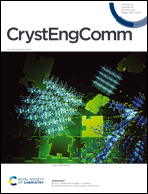Fine-tuning the pore structure of metal–organic frameworks by linker substitution for enhanced hydrogen storage and gas separation†
Abstract
The modification of metal–organic frameworks (MOFs) by functionalizing ligands has been investigated for improved properties. In this study, by introducing substituents to the backbone of organic linkers, isostructural dihydroxy-/dialkoxy-functionalized Zr-MOFs were delicately constructed and sophisticatedly characterized for crystallinity, morphology, porosity and structural defects. Pure-component CO2, CH4, N2, and H2 adsorption isotherms on the microporous synthesized materials were investigated under the pressure up to 10 MPa at 303 K. By the ideal adsorbed solution theory (IAST) model, enhanced adsorption selectivity towards CO2/N2, CO2/CH4, CH4/N2 and CO2/H2 binary mixtures was observed compared to the parent material, and dihydroxy functionalization endows the material with high selectivity towards CO2/H2. Moreover, the diethoxy-functionalized material with narrow cavities exhibits improved high pressure H2 adsorption due to structural defects and strong overlapping potentials.

- This article is part of the themed collection: Coordination Networks


 Please wait while we load your content...
Please wait while we load your content...